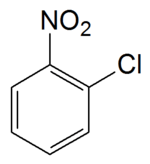2-Nitrochlorobenzene
2-Nitrochlorobenzene is an organic compound with the formula ClC6H4NO2. It is one of three isomeric nitrochlorobenzenes.[1] It is a yellow crystalline solid that is important as a precursor to other compounds due to its two functional groups.
 | |
| Names | |
|---|---|
| Preferred IUPAC name
1-Chloro-2-nitrobenzene | |
| Other names
2-Chloronitrobenzene | |
| Identifiers | |
3D model (JSmol) |
|
| ChEBI | |
| ChEMBL | |
| ChemSpider | |
| ECHA InfoCard | 100.001.686 |
| EC Number |
|
| KEGG | |
PubChem CID |
|
| RTECS number |
|
| UNII | |
| UN number | 1578 |
CompTox Dashboard (EPA) |
|
| |
| |
| Properties | |
| C6H4ClNO2 | |
| Molar mass | 157.55 g·mol−1 |
| Appearance | Yellow crystals |
| Density | 1.368 g/mL |
| Melting point | 33 °C (91 °F; 306 K) |
| Boiling point | 245.5 °C (473.9 °F; 518.6 K) |
| Insoluble | |
| Solubility in other solvents | Highly soluble in diethyl ether, benzene, and hot ethanol |
| Hazards | |
| Main hazards | Toxic, Irritant |
| GHS pictograms |     |
| GHS Signal word | Danger |
GHS hazard statements |
H301, H302, H311, H312, H317, H331, H332, H350, H351, H361, H372, H411 |
| P201, P202, P260, P261, P264, P270, P271, P272, P273, P280, P281, P301+310, P301+312, P302+352, P304+312, P304+340, P308+313, P311, P312, P314, P321, P322, P330, P333+313, P361 | |
| Flash point | 124 °C (255 °F; 397 K) |
Except where otherwise noted, data are given for materials in their standard state (at 25 °C [77 °F], 100 kPa). | |
| Infobox references | |
Synthesis
Nitrochlorobenzene is typically synthesized by nitration of chlorobenzene in the presence of sulfuric acid:
- C6H5Cl + HNO3 → O2NC6H4Cl + H2O
This reaction affords a mixture of isomers. Using an acid ratio of 30/56/14, the product mix is typically 34-36% 2-nitrochlorobenzene and 63-65% 4-nitrochlorobenzene, with only about 1% 3-nitrochlorobenzene.
Reactions
Alkylation and electrophilic aromatic substitution can occur at the chlorinated carbon center, and a diverse array of reactions can be carried out using the nitro group.[1] 2-Nitrochlorobenzene can be reduced to the 2-chloroaniline with Fe/HCl mixture, the Bechamp reduction. Treatment of 2-nitrochlorobenzene with sodium methoxide gives 2-nitroanisole.
Applications
2-Nitrochlorobenzene is not valuable in itself but is a precursor to other useful compounds. The compound is particularly useful because both of its reactive sites can be utilized to create further compounds that are mutually ortho. Its derivative 2-chloroaniline is a precursor to 3,3’-dichlorobenzidine, itself a precursor to many dyes and pesticides.
It is used in the synthesis of quetiapine & Clotiapine.
References
- Gerald Booth, "Nitro Compounds, Aromatic" in Ullmann's Encyclopedia of Industrial Chemistry, Wiley-VCH: Weinheim, 2005. doi:10.1002/14356007.a17_411